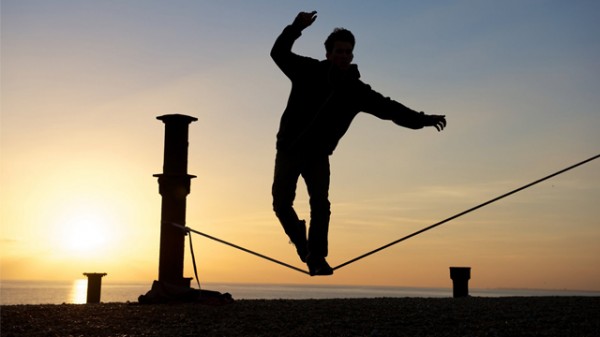1. Find your center of balance
If you don’t know where your center of gravity is, you will always be fighting it. Remove a limb and your normal center of gravity goes right out the window. When I started climbing again, I kept tipping to the right since my prosthetic leg was so much lighter than my leg before. Most of us climb in an X-shape or a modification of the three points of contact idea, but when you lose a leg, you can’t do that anymore. One trick I learned was to hang a long draw (at least 24”) on the belay loop of my harness. Climb up and the carabiner will swing between your legs and let you know where your center is. Make moves that put the draw hanging straight down between your legs. As you reach stances and particular holds, make slight adjustments to see the difference between feeling in balance and out of balance. Over time, it will become innate, and you will be able to anticipate and mitigate swings. This will make you more efficient in your movement.
2. Keep it weird
When you first start climbing, you can get by with your toes pointed straight at the rock or “froggie style,” using the inside edges of your feet and toes, heels angled slightly toward each other. As you progress and get onto harder climbs, these positions alone are not enough to work through technical, balance-intensive sequences. Three more moves will open up a whole new chapter in your climbing: back-steps, flags, and drop-knees. All three shift the position of your hips (and thus your center of balance), providing more options.
3. Climb one-legged
Try it! Hop or pogo with your leg when moving hold to hold. Turn your hips and core to counteract the balance. Hang low on your arms, bend at the knee, then in one fluid motion, rise up to the next handhold. As your hand reaches it, hop your foot to the next foothold. Be sure to identify the holds before you go; that way you can focus on being accurate. At first you will find that your body will tip to the legless side. Just let that happen and use the momentum it creates to propel you up. If you are having trouble controlling the swing, incorporate this with hanging a draw between your legs. Combining these two exercises will help you actually see how you have to adjust, and you can visualize and execute the particular movement needed. Don’t do big moves and don’t crank yourself up tight into a lockoff; this will only tire you out quickly and potentially hurt you. Instead, focus on smaller movements that will allow you to rest and counter the swing with your active leg.
4. Use your whole body
Too often we focus on pulling in with just our arms or stepping up with just a leg, when in reality engaging your whole body from fingertips to toes is what you need. A large part of this is your core: obliques, hamstrings, butt, lower back, etc. Think about activating your entire body for every move; you’ll swing less and feel more in control. Another part of this, especially important for trad climbing, is to think of every part of your body as another appendage. I smear my hip and knee onto the rock underneath or to the side. In corners, lean your shoulder against the rock to get a decent rest or to stop a barn door.
5. Avoid staying vertical
We all begin climbing by trying to keep our bodies in a vertical position, but that won’t get you very far as moves get harder and terrain becomes varied. Think about climbing with one leg again, centering over one active foot. Pulling with your upper body to keep your body straight up and down wastes strength. Try letting your hips slide to where your other leg should be; that position should feel more effortless and natural. To move upward, shift your weight back over your active foot, letting the energy from your hips move you to the next hold. To move in the opposite direction, simply stand up as high as possible on your active leg, again letting the momentum come from your hips.
By Craig DeMartino
